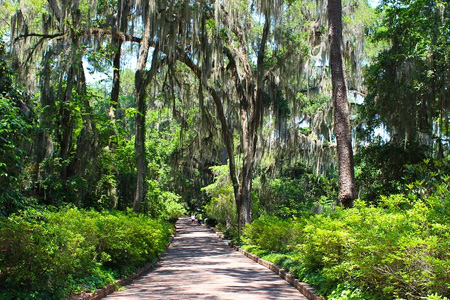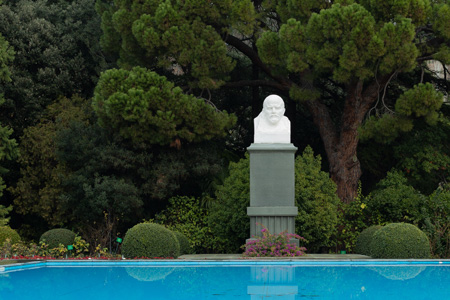Nikitsky Botanical Garden is a hidden gem of an attraction. Known for its picturesque scenery and peaceful atmosphere, it’s well worth visiting if you happen to be travelling to the southern part of Crimea. It’s home to a diverse collection of plants and is strongly recommended for anyone interested in botany, floristry or nature in general. There are more than fifty thousand species and variations to be seen throughout, from well-known plants to exotic ones that aren’t as commonly seen.
Roughly eleven square kilometres in size, Nikitsky Botanical Garden is big enough that you can easily spend a few hours here admiring all the plants and taking in the views. While its flower and plant displays are a real feast for the eyes, the garden is more than just a display of attractive flora; in fact, it’s where a lot of important scientific research takes place. Many fruit trees found throughout the region exist because of the garden. They were acclimatised here before being relocated elsewhere.
This page offers a detailed summary of the garden today. Have a read to find out more, and once you’re done, you may want to come and visit the place yourself.

Location
Nikitsky Botanical Garden is located within the village of Nikita, which is home to just over two thousand people. The village is on the southern coast of the Autonomous Republic of Crimea and is a short distance from the resort city of Yalta. Thanks to its many attractions, which include parks, museums, a zoo and various historical buildings, the city attracts plenty of tourists. Many of these visit the nearby village of Nikita to pay a visit to the Nikitsky Botanical Garden. The garden lies not too far from the Black Sea, which can be seen from many places throughout the site.
History
Nikitsky Botanical Garden holds the distinction of being one of the oldest botanical gardens in all of Europe. It’s been open to the public since 1812 and has been delighting visitors for over two hundred years. It was named after the village of Nikita, in which it’s located, and was set up by Christian Steven, who was a Russian-Swedish botanist. He was the garden’s first director and remained in the role for many years. Another botanist from Russia, Nicolai Anders von Hartwiss, acted as the director from 1827-60 and expanded both the size of the garden and its range of plants.
Over the years, the garden has grown in size thanks to several new sections that have been added. Nowadays, it’s a fairly popular tourist attraction, attracting a mix of locals, people from elsewhere in Crimea and visitors from abroad. It’s important to the local economy as it employs some people living in the vicinity. It’s also important to the wider regional economy since it helps attract people to the area.

Visiting The Garden
From the centre of Yalta, it should take around twenty minutes by car or taxi to reach the garden. There is a local bus service that runs from Yalta and stops at the garden, though this is the slower option. If you decide to go on the bus, it can take around an hour to reach the garden from the city centre. If you choose this option, why not enjoy the extra time with a game of roulette at a top casino site? You can find a list of them here. The busses to take are as follows:
- No. 29 from the Pionerskaya stop in Yalta
- No. 34 from the Veshchevoi market stop in Yalta
There’s also the option to get the trolleybus No. 2 or No. 53 from the Veshchevoi market stop. Whichever bus or trolleybus you decide to get, Nikitsky Botanical Garden will be the last stop. Both the bus and the trolleybus conveniently take you right up to the garden’s main entrance.
When you get there, tickets can be bought at the main reception building. For adults, the cost of a ticket is two hundred rubles, while for schoolchildren they’re reduced to a hundred rubles. If you want to visit the on-site museum, the cost is an extra fifty rubles for adults and twenty-five for schoolchildren. There are various discounts available for people who meet certain criteria, such as disabled people and carers, WWII veterans and large groups.
From November to April, the garden’s open from every day from 9:00 am to 4:00 pm. The closing time is extended to 8:00 pm from May to October. If you visit during the summer season, the garden may have quite a lot of visitors, but it shouldn’t be too crowded to spoil your day. The beauty of a garden like this is that even if there are lots of people there, you should still be able to wander about and find a quieter area where you can escape the crowds and relax.
The advantage of visiting when the garden’s open later is that you can experience it at sunset. While it’s a beautiful place to be during the day, viewing the many plants and flowers as the sun goes down is very worthwhile indeed; it makes the place seem even more attractive and special than it already is.
Features
Nikitsky Botanical Garden, like other similar attractions, is split into several different sections. Each one of these has something different worth seeing, so if you do pay a visit to the garden, be sure to explore each and every section. Here’s a summary of some of the garden’s different sections:
- Upper Park. Here you’ll see a bust of the park’s founder overlooking a serene rectangular pond. A range of trees such as sequoias, cedars and cypresses can be found here, along with a number of other coniferous trees and flowers such as chrysanthemums and tulips. This section is the first you’ll get to experience when you visit the garden. For an extra charge, you can enter the cactus greenhouse, which is home to one of Europe’s largest collections of plants that can tolerate droughts and desert-like conditions. There are over a thousand species that can be seen here, including over six hundred cactus species.
- Lower Park. This is a section that was added after the garden was first opened. It’s located near the research centre and is home to a wide variety of exotic plants. There’s even an olive tree that’s over seven hundred years old. Other features include a pond with water lilies and a cascading pool with an adjoining staircase.
- Seaside Park. This section was established in celebration of the garden’s two hundredth year of operation. It focuses on colourful, tropical flowers and plants that thrive in hot, humid weather.
- Park Montedor. Designed to celebrate the garden’s one hundred and fiftieth anniversary, this section is where you’ll find an assortment of regional and national plants. Most of the plants here can’t be found outside of Crimea and usually grow in woodland areas.
- Paradise Gardens. This section debuted in 2009 and is set within a hectare of land. It’s home to over 5,000 plant species and is known for being one of the garden’s most scenic and peaceful areas.
- Primorsky Park. In this section of the garden, there are over a dozen life-size statues of dinosaurs dotted about. These were added in 2015 to complement the many plants in the garden that date back to the time of the dinosaurs. There’s a small excavation area where kids can pretend to be archaeologists and go digging in the sand. The dinosaur statues are made to be realistic: they make breathing movements and sounds, and can move about on the spot.
Throughout the year, the garden plays host to a number of seasonal and limited-time exhibitions and displays. For example, in the spring there’s the Tulip Parade, where you can see tulips and all sorts of other flowers. Then in the summer, flowering plants such as lilies, hibiscuses and hydrangeas are under the spotlight. Towards the end of the year, there’s the Chrysanthemum Ball, which is an explosion of colour and is particularly popular with visitors. During this special event, visitors can vote for their favourite type of chrysanthemum on display, with the winner awarded a special title at the end of the ten-day exhibition.
If you’d like to see the garden for yourself from the comfort of your own home, watch this short video. It gives a glimpse of what the garden’s like and what it has to offer. You’ll find quite a few similar videos on YouTube that give you tours of the garden and its different sections. While videos give you a preview, of course, there’s nothing quite like visiting the garden yourself and taking in the pleasant sights and smells of the many plants that call the place home.
Facilities
With the garden being a site of scientific research, as well as a museum, there’s a research centre where botanists, biologists and the like study plants and carry out various experiments. There are hundreds of people in different areas of research working here, from full-time professionals to university students.
As well as the research facilities, Nikitsky Botanical Garden has a library (the oldest in Crimea) and a tasting room. Here, you’re able to sample some of the many fruits and produce grown on-site. There’s also a souvenir shop with a range of keepsakes and gifts to purchase, and a cafeteria where visitors can relax with some food and drinks.
All in all, the garden offers just about everything you need for a memorable day out. If you’re into botany, you’ll no doubt find the site’s collection fascinating; even if you’re not as into plants, you’re sure to enjoy walking throughout the garden and admiring all the different plant species. Whatever your level of interest, a visit to the garden is definitely worthwhile. As well as getting to see a diverse assortment of plants from around the world, you can enjoy a day out in the fresh air and maybe even learn a thing or two about botany while you’re here.
Summary
Nikitsky Botanical Garden is a delightful tourist attraction situated along the southern coast of Crimea. It’s open year-round and is an excellent choice for a good day out. It’s home to a vast collection of plants from all over the world, from exotic flowers to native trees and everything in between. The list of species that can be seen here is incredibly long, making the place an excellent choice for anyone interested in plants.
If you happen to be visiting the area, Nikitsky Botanical Garden shouldn’t be overlooked. Enjoy a relaxing and peaceful day out surrounded by pretty flowers and plants from all four corners of the globe. Take some great photos to share with your friends and spend a few hours unwinding in beautifully landscaped surroundings.
This page gives an overview of the garden. If you’re interested in finding out more, visit the official website or, if you can, visit the garden in person. There’s a wealth of information you can learn at the place itself, not only to do with its history and how it’s changed over the years, but also to do with its impressive collection of plants and the research that’s being carried out. Nikitsky Botanical Garden is a must-see attraction for anyone visiting the southern coast of Crimea. Make sure you stop by the next time you’re in the are and enjoy a delightful time in a particularly scenic place.
